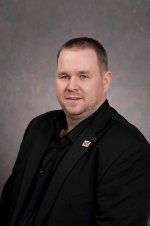johnwartjr
Senior Member
I worked with studio lights a bit when I shot film for the family business back in the 90s. Admittedly, though, I never had to design my own solution from scratch - I had a book with patterns in it - an X where the subject went, each light, the tripod, etc, and measurements connecting all the points - so it could be repeated time and time again.
Granted, there were times where an adjustment needed to be made due to the height of someone, or the size of a group.
Today, while most of my photography is for personal enjoyment, I do a little bit of photo business on the side. A handful of weddings every year, a handful of events, etc.
One of my better clients asked me if I could come in and do some headshots for them. To do this, I'm going to have to set up a small studio in one of their locations for a part day.
So, I'm looking through my equipment, trying to decide what to use, and to figure out if I need anything else to add to my arsenal.
I need a decent background. I am going to head to my local camera store, and pick up a neutral color Savage 5x7 pop up muslin background and stand. Having used plenty of muslins in the past, I remember how they liked to wrinkle. The pop up ones apparently stretch 'flat' with the frame.
I plan to shoot using my D700 and my 85 1.4G
Lighting wise, I have a fair number of things in my kit.
I have
2 - SB-900 Flashes
1- Yongnuo YN-565-EX Flash
1 - Pocketwizard Mini TT1
2 - Pocketwizard Flex TT5
1 - Pocketwizard AC3 Zone controller
4 - Alienbee AB800 strobes
I'm a little 'light' on modifiers. I have 2 shoot through umbrellas, 2 silver umbrellas, and an octabox. And a decent reflector with stand.
And of course, various light stands, tripods, etc
Should I shoot headshots with my subject standing, or sitting?
If sitting, chair or stool?
Any suggestions? I am going to get the background early next week, and will set something up in my basement to get a feel for it. Just thought maybe someone had been there, and could offer some good advice.
And, if people are willing, perhaps I could post a few of my pics for critique, once I get there.
Granted, there were times where an adjustment needed to be made due to the height of someone, or the size of a group.
Today, while most of my photography is for personal enjoyment, I do a little bit of photo business on the side. A handful of weddings every year, a handful of events, etc.
One of my better clients asked me if I could come in and do some headshots for them. To do this, I'm going to have to set up a small studio in one of their locations for a part day.
So, I'm looking through my equipment, trying to decide what to use, and to figure out if I need anything else to add to my arsenal.
I need a decent background. I am going to head to my local camera store, and pick up a neutral color Savage 5x7 pop up muslin background and stand. Having used plenty of muslins in the past, I remember how they liked to wrinkle. The pop up ones apparently stretch 'flat' with the frame.
I plan to shoot using my D700 and my 85 1.4G
Lighting wise, I have a fair number of things in my kit.
I have
2 - SB-900 Flashes
1- Yongnuo YN-565-EX Flash
1 - Pocketwizard Mini TT1
2 - Pocketwizard Flex TT5
1 - Pocketwizard AC3 Zone controller
4 - Alienbee AB800 strobes
I'm a little 'light' on modifiers. I have 2 shoot through umbrellas, 2 silver umbrellas, and an octabox. And a decent reflector with stand.
And of course, various light stands, tripods, etc
Should I shoot headshots with my subject standing, or sitting?
If sitting, chair or stool?
Any suggestions? I am going to get the background early next week, and will set something up in my basement to get a feel for it. Just thought maybe someone had been there, and could offer some good advice.
And, if people are willing, perhaps I could post a few of my pics for critique, once I get there.


